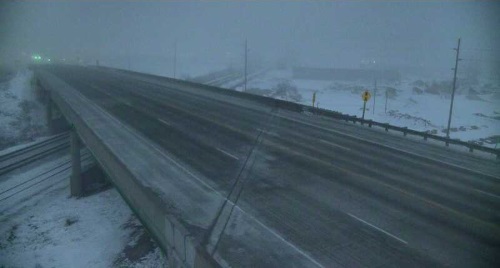Could more accurate and consistent pavement temperature data held reduce the overuse of salt and other ice-melting chemicals during winter operations? The Iowa Department of Transportation plans to find out via a new one-year pilot program it recently launched.
[Photo courtesy of the Iowa Department of Transportation.]
Road salt – also known as sodium chloride – is widely used as a pavement deicer in the United States and other countries, yet it is an increasing source of concern as it accumulates in lakes, streams, and other bodies of water. In 2017, the Minnesota Department of Transportation released a 128-page study that sodium chloride infiltrated pervious areas adjacent to the streets after being plowed or splashed over curbs by traffic. That report showed, in part, that reducing the amount of sodium chloride and other road-clearing chemicals deployed by snowplows depends on the broad availability and accuracy of road temperature data.
Tina Greenfield, who works in the Iowa DOT’s maintenance bureau, noted in a blog post that its highway maintenance supervisors rely on pavement temperature data to determine what treatment options to deploy during winter storms – such as granular salt or brine – and in what quantities to either pretreat the roads or break up snow and ice.
Currently, the Iowa DOT collects pavement temperature via more than 70 Roadway Weather Information System, or RWIS, stations positioned around the state – stations owned and maintained by the agency.
However, those stations cannot collect data on every stretch of highway maintained by the Iowa DOT – leaving a number of large “data gaps” throughout the system.
To close those gaps, the agency is conducting a pilot project to purchase “data as a service.” The project will collect data recorded by smaller, privately owned battery-operated units using infrared technology to sense pavement temperatures and relay the data over a cellular connection.
“This is very similar to the sensor technology we have in our snow plow trucks,” Greenfield explained “Since we’re just purchasing the data, we don’t incur any of the cellular or power costs,” she added. “By using infrared technology, there are no sensors in the pavement to install or maintain.”
[Want to know more about snow and ice fighting tactics? Check out the winter operations podcast put together by the American Association of State Highway and Transportation Officials Snow and Ice Pooled Fund Cooperative Program, known as “SICOP.”]
She noted that the pilot project also allows her agency to choose the vendors supplying and maintaining this data collecting and reporting equipment “We simply purchase that data that equipment gathers,” Greenfield emphasized. “If these work out, this can be a very affordable way to get the data. This allows us to gather more data without having to invest in hardware and technology.”

